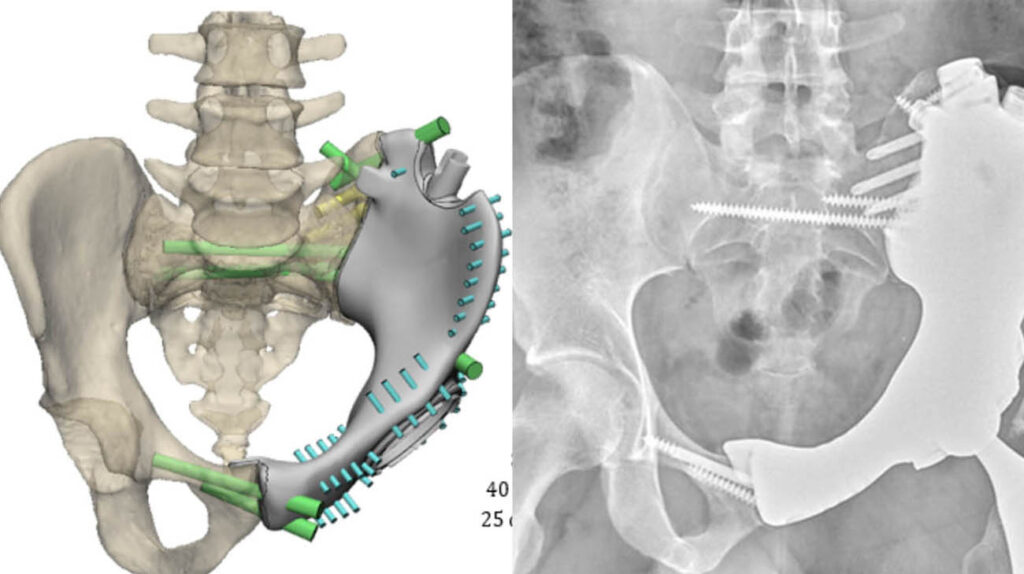
Knee pain rarely bothered Rayshaun Smith. As an athletic and active U.S. Army staff sergeant, the 32-year-old Cleveland, Ohio, native was accustomed to putting a strain on his body. Whether on maneuvers in South Korea, or instructing young cadets at West Point in New York, Rayshaun endured the injuries commonly sustained as an active-duty soldier.
The pain – which was centered on his left knee – persisted but Rayshaun recalls, “I never rarely gave it much thought. I would ice it down and move on.”
As it worsened, he visited several medical professionals, who typically prescribed painkillers. Even after undergoing imaging scans of his knee, providers still couldn’t identify the problem. Finally, a physical therapist in Dayton, Ohio, during a new assignment in 2020, began moving Rayshaun’s left leg in different directions. One of the angles sent searing pain throughout Rayshaun’s knee and leg. He recalls the practitioner telling him, “The problem is not your knee. It’s your hip.”

And the problem was much worse than he anticipated. Subsequent MRI and CT tests revealed the source of Rayshaun’s pain: a large, grade 3 sarcoma in the left side of his pelvis which was creating referred pain in the nerve leading to his knee. A relatively rare form of cancer, a sarcoma is a tumor that develops in bone and connective tissue, such as fat, muscle, blood vessels, nerves and the tissue that surrounds bones and joints. Less than 1% of adults with a cancer diagnosis are diagnosed with sarcoma.
Shortly after the diagnosis, Rayshaun’s oncologist at the time referred him to Cleveland Clinic orthopedic surgeon and Section Head of Orthopedic Oncology, Nathan Mesko, MD.
As Dr. Mesko describes the situation, there were two main options for treatment. One was to remove the cancer, while also amputating Rayshaun’s leg. The other was to perform a complex surgical procedure that would precisely resect the cancer and a large portion of Rayshaun’s left hemipelvis and replace it with a custom-designed, 3D-printed, titanium-constructed pelvic implant.

“Years ago, he would have lost his leg or, at best, not been able to use it because the pelvis would no longer be connected to the leg,” states Dr. Mesko. “But with today’s advanced medical techniques, anything is possible. With Rayshaun, we created specialized guides to aid in accurately resecting the cancer, then engineered and 3D-printed a custom pelvic implant to rebuild the defect. Now we can get rid of the cancer, preserve the leg and restore Rayshaun’s function.”
While shocked after receiving his diagnosis, Rayshaun didn’t hesitate to undergo the innovative procedure. “In the Army, you’re used to doing whatever needs to be done. And this needed to be done.”
Because Rayshaun’s type of sarcoma didn’t require him to undergo chemotherapy or radiation, either before or after the surgery, Dr. Mesko quickly began the process of planning both the complex operation and the design of the prosthetic that would serve as Rayshaun’s new and exact replica of his left hemipelvis.
Working with several engineers and developers, and with colleagues at Cleveland Clinic, Dr. Mesko used numerous scans of Rayshaun’s pelvis to map out every aspect of the surgery – from incision entry points and suture angles to the exact amount and location of the bone and tissue that would need to be removed. Additionally, they used the images to construct a model that would ultimately be used to produce the final 3D-printed pelvic implant.

“Compared to 10 years ago, when custom pelvis was almost never done, our technology is becoming better suited to providing a clean cancer resection and an opportunity for reconstruction in defects that otherwise would have no other solution than to either amputate or leave a flail or loose hanging limb,” notes Dr. Mesko.
The entire process, including obtaining necessary approvals, was completed in about eight weeks. In May 2022, during a 10-hour surgery, Dr. Mesko performed the surgical procedure of removing the sarcoma and affected bones and tissue and then replacing them with the customized pelvic implant.
The surgery was completed without complications. Rayshaun remained in the hospital for 10 days. For more than a month while his body healed, he was not allowed to undergo physical therapy. Afterwards, he underwent several months of intense physical therapy. As Dr. Mesko notes, his recovery was enhanced by his young age and being in excellent physical condition.

While Rayshaun walks with a slight limp, it doesn’t keep him from resuming the intense personal training and workouts he has been accustomed to for years. Rayshaun is retired from the Army and currently resides in Bakersfield, California.
He returns to Cleveland Clinic main campus every 3 to 6 months for follow-up testing. In January 2024, scans revealed a small growth of cancer near his femur. Dr. Mesko was able to remove the growth with a minor surgical procedure that required one day in the hospital. Rayshaun currently shows no evidence of cancer.
“I’m blessed to have had the opportunity to get this kind of treatment,” says Rayshaun, “It’s pretty amazing.”
